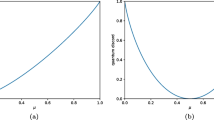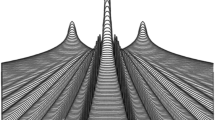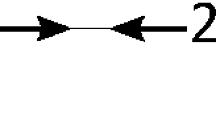Abstract
We calculate the energy levels of a system of neutrinos undergoing collective oscillations as functions of an effective coupling strength and radial distance from the neutrino source using the quantum Lanczos (QLanczos) algorithm implemented on IBM Q quantum computer hardware. Our calculations are based on the many-body neutrino interaction Hamiltonian introduced in Patwardhan et al. (Phys Rev D 99, https://doi.org/10.1103/PhysRevD.99.123013, 2019). We show that the system Hamiltonian can be separated into smaller blocks, which can be represented using fewer qubits than those needed to represent the entire system as one unit, thus reducing the noise in the implementation on quantum hardware. We also calculate transition probabilities of collective neutrino oscillations using a Trotterization method which is simplified before subsequent implementation on hardware. These calculations demonstrate that energy eigenvalues of a collective neutrino system and collective neutrino oscillations can both be computed on quantum hardware with certain simplification to within good agreement with exact results.




Similar content being viewed by others
References
Patwardhan, A.V., Cervia, M.J., Balantekin, A.B.: Eigenvalues and eigenstates of the many-body collective neutrino oscillation problem. Phys. Rev. D 99,(2019). https://doi.org/10.1103/PhysRevD.99.123013
Kajita, T.: Atmospheric neutrinos and discovery of neutrino oscillations. Proc. Jpn. Acad. Ser. Phys. Biol. Sci. 86(4), 303–321 . https://doi.org/10.2183/pjab.86.303
Fukuda, Y., et al.: (Super-Kamiokande collaboration), evidence for oscillation of atmospheric neutrinos. Phys. Rev. Lett. 81, 1562 (1998). https://doi.org/10.1103/PhysRevLett.81.1562
Ahmad, Q.R., et al.: (SNO collaboration),”measurement of the rate of \(\nu _e + d \rightarrow p + p + e^{-}\) interactions produced by \(^8 B\) solar neutrinos at the Sudbury neutrino observatory”. Phys. Rev. Lett. 87,(2001). https://doi.org/10.1103/PhysRevLett.87.071301
An, F.P., et al.: (Daya Bay Collaboration), ”Observation of electron-antineutrino disappearance at Daya Bay.” Phys. Rev. Lett. 108, (2012). https://doi.org/10.1103/PhysRevLett.108.171803
Neutrino, L.: Neutrino oscillations in matter. Phys. Rev. D 17, 2369 (1978). https://doi.org/10.1103/PhysRevD.17.2369
Duan, H., Fuller, G.M., Qian, Y.Z.: Collective neutrino oscillations. Annu. Rev. Nucl. Part. Sci. 60(1), 569–594 (2010). https://doi.org/10.1146/annurev.nucl.012809.104524
Abazajian, K.N., Beacom, J.F., Bell, N.F.: Stringent constraints on cosmological neutrino-antineutrino asymmetries from synchronized flavor transformation. Phys. Rev. D 66,(2002). https://doi.org/10.1103/PhysRevD.66.013008
Wu, M.R., Qian, Y.Z., Martinez-Pinedo, G., Fischer, T., Huther, L.: Effects of neutrino oscillations on nucleosynthesis and neutrino signals for an 18 M\(\odot \) supernova model. Phys. Rev. D 91, 065016 (2015). https://doi.org/10.1103/PhysRevD.91.065016
Martínez-Pinedo, G., Fischer, T., Langanke, K., Lohs, A., Sieverding, A., Wu, M.-R.: Neutrinos and their impact on core-collapse supernova nucleosynthesis, In: Alsabti A., Murdin P. (eds.) Handbook of Supernovae. Springer, Cham. (2016). https://doi.org/10.1007/978-3-319-20794-0_78-1
Nachman, B., Provasoli, D., de Jong, W.A., Bauer, C.W.: Quantum algorithm for high energy physics simulations. Phys. Rev. Lett. 126, (2021). https://doi.org/10.1103/PhysRevLett.126.062001
Noh, C., Rodriguez-Lara, B.M., Angelakis, D.G.: Quantum simulation of neutrino oscillations with trapped ions. New J. Phys. 14, (2012). https://doi.org/10.1088/1367-2630/14/3/033028/pdf
Argüelles, C.A., Jones, B.J.P.: Neutrino oscillations in a quantum processor. Phys. Rev. Res. 1, 033176 (2019). https://doi.org/10.1103/PhysRevResearch.1.033176
Motta, M., Sun, C., Tan, A.T.K., O’Rourke, M.J., Ye, E., Minnich, A.J., Brandão, F.G.S.L., Chan, G.K.-L.: Determining eigenstates and thermal states on a quantum computer using quantum imaginary time evolution. Nature Physics 16, 205–210 (2020). https://www.nature.com/articles/s41567-019-0704-4
Hall, B., Roggero, A., Baroni, A., Carlson, J.: Simulation of collective neutrino oscillations on a quantum computer. arXiv: 2102.12556 [quant-ph] (2021)
Yeter-Aydeniz, K., Pooser, R. C., Siopsis, G.: Practical quantum computation of chemical and nuclear energy levels using quantum imaginary time evolution and Lanczos algorithms. npj Quantum Inf. 6, 63 (2020). https://www.nature.com/articles/s41534-020-00290-1.pdf
Yeter-Aydeniz, K., Siopsis, G., Pooser, R.C.: Scattering in the Ising model with the quantum Lanczos algorithm. New J. Phys. in press (2021). https://doi.org/10.1088/1367-2630/abe63d
Cervia, M.J., Patwardhan, A.V., Balantekin, A.B., Coppersmith, S.N., Johnson, C.W.: Entanglement and collective flavor oscillations in a dense neutrino gas. Phys. Rev. D 100, 083001 (2019). https://doi.org/10.1103/PhysRevD.100.083001
Yeter-Aydeniz, K., Gard, B. T., Jakowski, J., Majumder, S., Barron, G. S., Siopsis, G., Humble, T., Pooser, R. C.: Benchmarking quantum chemistry computations with variational, imaginary time evolution, and Krylov space solver algorithms. arXiv: 2102.05511 [quant-ph] (2021)
McArdle, S., Jones, T., Endo, S., Li, Y., Benjamin, S.. C., Yuan, X.: Variational ansatz-based quantum simulation of imaginary time evolution. npj Quant. Inf. 5, 75 (2019). https://www.nature.com/articles/s41534-019-0187-2
Eastin, B., Flammia, S. T.: Q-circuit tutorial. arXiv: quant-ph/0406003v2 (2004)
Balantekin, A.B., Pehlivan, Y.: Neutrino-neutrino interactions and flavour mixing in dense matter. J. Phys. G Nucl. Part. Phys. 34, 47–65 (2007). https://doi.org/10.1088/0954-3899/34/1/004/pdf
Roggero, A., Carlson, J.: Dynamic linear response quantum algorithm. Phys. Rev. C 100, (2019). https://doi.org/10.1103/PhysRevC.100.034610
Rrapaj, E.: Exact solution of multiangle quantum many-body collective neutrino-flavor oscillations. Phys. Rev. C 101, (2020). https://doi.org/10.1103/PhysRevC.101.065805
Sun, S.-N., Motta, M., Tazhigulov, R.N., Tan, A.T.K., Chan, G.K.-L., Minnich, A.J.: Quantum computation of finite-temperature static and dynamical properties of spin systems using quantum imaginary time evolution. PRX Quant. 2, (2021). https://doi.org/10.1103/PRXQuantum.2.010317
Davis, M. G., Smith, E., Tudor, A., Sen, K., Siddiqi, I.: QGo: scalable quantum circuit optimization using automated synthesis. arXiv: 2012.09835 [quant-ph] (2020)
Wu, X.-C., Davis, M.G., Chong, F.T., Iancu, C.: QGo: scalable quantum circuit optimization using automated synthesis. arXiv: 2012.09835 [quant-ph] (2021)
Dumitrescu, E.F., McCaskey, A.J., Hagen, G., Jansen, G.R., Morris, T.D., Papenbrock, T., Pooser, R.C., Dean, D.J., Lougovski, P.: Cloud quantum computing of an atomic nucleus. Phys. Rev. Lett. 120,(2018). https://doi.org/10.1103/PhysRevLett.120.210501
Kyriienko, O.: Quantum inverse iteration algorithm for programmable quantum simulators. npj Quant. Inf. 6, 7 (2020). https://www.nature.com/articles/s41534-019-0239-7
Seki, K., Yunoki, S.: Quantum power method by a superposition of time-evolved states. PRX Quant.2,(2021). https://doi.org/10.1103/PRXQuantum.2.010333
Suchsland, P., Tacchino, F., Fischer, M. H., Neupert, T., Barkoutsos, P. Kl., Tavernelli,I.: Algorithmic error mitigation scheme for current quantum processors. arXiv: 2008.10914v2 [quant-ph] (2021)
Alexeev, Y., Bacon, D., Brown, K.R., Calderbank, R., Carr, L.D., Chong, F.T., DeMarco, B., Englund, D., Farhi, E., Fefferman, B., Gorshkov, A.V., Houck, A., Kim, J., Kimmel, S., Lange, M., Lloyd, S., Lukin, M.D., Maslov, D., Maunz, P., Monroe, C., Preskill, J., Roetteler, M., Savage, M.J., Thompson, J.: Quantum computer systems for scientific discovery. PRX Quantum 2, (2021). https://doi.org/10.1103/PRXQuantum.2.017001
Iten, R., Colbeck, R., Kukuljan, I., Home, J., Christandl, M.: Quantum circuits for isometries. arXiv: 1501.06911 [quant-ph]
Acknowledgements
We acknowledge useful discussions with A. Baha Balantekin. The quantum circuits were drawn using the Q-circuit package [21]. This work was supported by the Quantum Information Science Enabled Discovery (QuantISED) for High Energy Physics program at ORNL under FWP number ERKAP61 and used resources of Oak Ridge Leadership Computing Facility located at ORNL, which is supported by the Office of Science of the Department of Energy under Contract No. DE-AC05-00OR22725. The authors acknowledge use of the IBM Q for this work. The views expressed are those of the authors and do not reflect the official policy or position of IBM or the IBM Q team. G.S. is supported by ARO Grant W911-NF-19-1-0397 and NSF Grant OMA-1937008.
This manuscript has been authored by UT-Battelle, LLC, under Contract No. DE-AC0500OR22725 with the U.S. Department of Energy. The United States Government retains and the publisher, by accepting the article for publication, acknowledges that the United States Government retains a non-exclusive, paid-up, irrevocable, worldwide license to publish or reproduce the published form of this manuscript, or allow others to do so, for the United States Government purposes. The Department of Energy will provide public access to these results of federally sponsored research in accordance with the DOE Public Access Plan. KYA: The author’s affiliation with The MITRE Corporation is provided for identification purposes only, and is not intended to convey or imply MITRE’s concurrence with, or support for, the positions, opinions or viewpoints expressed by the author.
Author information
Authors and Affiliations
Corresponding author
Additional information
Publisher's Note
Springer Nature remains neutral with regard to jurisdictional claims in published maps and institutional affiliations.
Appendices
Appendix A: QITE algorithm
In this appendix, we briefly discuss the quantum imaginary-time evolution (QITE) algorithm which provides the basis for the quantum Lanczos (QLanczos) algorithm that is used to calculate the energy spectrum of the collective neutrino system that we studied.
In the QITE algorithm, the non-unitary imaginary-time evolution operator \({\mathfrak {U}} =e^{- \beta H_\text {block}}\) for imaginary-time evolution of an initial state can be expressed as
after dividing the imaginary-time evolution into n small steps with \(\Delta \tau =\frac{\beta }{n}\). We included a normalization constant \(c_n=\frac{1}{\sqrt{\langle \Psi _0|{\mathfrak {U}}^2|\Psi _0\rangle }}\). The sth step of this imaginary-time evolution is approximated by real-time evolution in terms of a unitary operator as
where \(c_s\) is a normalization constant that can be calculated recursively starting with \(c_0=1\). The unitary update operators can be written as
where \(I=\{i_0,\dots , i_{n_q-1}\}\), \(n_q\) is the number of qubits for the reduced block Hamiltonian, and \(\sigma \in \{X,Y,Z\}\) are Pauli operators. The coefficients \(a_I[s]\) are calculated by solving the linear system of equations \(({{\varvec{{\mathcal {S}}}}}+{{\varvec{{\mathcal {S}}}}}^T)\cdot {{\varvec{a}}}={{\varvec{b}}}\) up to order \({\mathcal {O}}(\Delta \tau ^2)\), where
These expectation values are calculated with respect to the state in the previous QITE step, \(|\Psi _{s-1}\rangle \). The exponentially growing size of the matrices \({{\varvec{b}}}\) and \({{\varvec{{\mathcal {S}}}}}\) challenges the scalability of the algorithm. In our case, certain properties of the Hamiltonian, such as real matrix elements, help us reduce the size of these matrices. Due to the large number of measurements required for the calculation of matrix elements on quantum hardware accessible through cloud services, for a timely completion of calculations some of our measurements were performed using a noisy simulator instead. This resulted in a reduction of overall error but did not affect results significantly, as was ascertained by a comparison of results between sample quantum hardware and simulated runs.
We point out that circuit bundling, which is sometimes used to minimize the size of jobs submitted for quantum hardware runs, is not an option in our case, because the outcome of each step is used in the following step. Moreover, the QITE algorithm requires single- and two-qubit gates at each step resulting in a quantum circuit depth exceeding the decoherence time in NISQ devices. We took steps to shorten the quantum circuits by adapting methods we introduced in our earlier work [17, 19].
In detail, we started by determining the number of QITE steps in the implementation of our algorithm. We selected the number of steps that yielded convergence of energy expectation values within \(\epsilon =0.001\) of the ground state energy. We used this criterion to estimate the required number of steps numerically. Then, we ran experiments on a noisy simulator of the quantum device that produced the matrix elements for \({\varvec{S}}\) and \({\varvec{b}}\) at each step, and used them to solve classically the system of equations \(({{\varvec{{\mathcal {S}}}}}+{{\varvec{{\mathcal {S}}}}}^T)\cdot {{\varvec{a}}}={{\varvec{b}}}\) obeyed by the coefficients \(a_I[s]\) introduced in Eq. (A3). Next, to shorten the depth of the quantum circuit so it is manageable by NISQ devices, we employed the isometry function from the IBM Qiskit library which uses the algorithm developed in [33] where a given isometry is decomposed into single-qubit and Controlled-NOT (CNOT) gates with the aim of having the least number of CNOT gates. We used this isometry function to simplify the circuits of the state at the sth step,
It turns out that the resulting quantum circuit at each QITE step has the same gate components but with different rotation angles making the implementation of the QITE algorithm possible on NISQ devices. We ran these quantum circuits on IBM Q quantum hardware to obtain experimental energy expectation values.
Appendix B: transition probabilities calculated on different 7-qubit hardware
In this section, we present the collective neutrino oscillations transition probability results that we obtained from currently available 7-qubit IBM Quantum hardware. Fig. 6a, b compares the 3-neutrino (4-neutrino) oscillations transition probability values from \(|\Psi _{\text {initial}}\rangle =|\nu _e \nu _e \nu _e\rangle \) (\(|\Psi _{\text {initial}}\rangle =|\nu _e \nu _e \nu _e \nu _e\rangle \)) to \(|\Psi _{\text {final}}\rangle =|\nu _e \nu _e \nu _e\rangle \) (\(|\Psi _{\text {final}}\rangle =|\nu _e \nu _e \nu _e \nu _e\rangle \)). In each panel, the transition probabilities obtained from exact Trotterization, noiseless simulator, noisy simulator of the particular quantum hardware, and 7-qubit IBM Quantum hardware are plotted. We ran the experiments on IBM Quantum Casablanca, Jakarta, and Lagos (from top to bottom) devices. These devices have processor type of Falcon r5.11H and their gate maps can be seen in Fig. 5. In each of these runs we used \(N_{\text {shots}}=8192\) and each experiment were run \(N_{\text {runs}}=2\) times. For the experiments run in Casablanca and Jakarta we used qubits [2,1,3] ([2,1,3,5]) for 3-qubit (4-qubit) runs and for the experiments run in Lagos we used qubits [3,5,6] ([1,3,5,6]) for 3-qubit (4-qubit) runs. The experiments conducted on IBM Quantum Casablanca and Jakarta were run on 9/23/2021 and the experiments run on Lagos were run on 9/16/2021.
The transition probability amplitude comparison for transition from (a) \(|\text {initial}\rangle =|\nu _e \nu _e\nu _e\rangle \) to \(|\text {final}\rangle =|\nu _e\nu _e\nu _e\rangle \), (b) \(|\text {initial}\rangle =|\nu _e \nu _e\nu _e\nu _e\rangle \) to \(|\text {final}\rangle =|\nu _e\nu _e\nu _e\nu _e\rangle \) as a function of time between exact time evolution calculations, noiseless simulated Trotterization and values obtained using Trotterization implemented on the three different 7-qubit IBM Q hardware (Casablanca, Jakarta, and Lagos, from top to bottom). The error mitigation method applied is readout error mitigation (ROEM). The parameters are chosen such that \(\sin ^2\left( 2\theta \right) =0.10\), \(\omega _p=p\omega _0\) and \(\mu (r)/\omega _0=1.0 \). The experiments were run \(N_{\text {run}}=3\) times on 9/23/2021 for systems Casablanca and Jakarta and on 9/16/2021 for Lagos. The error bars represent \(\pm \sigma \)
In Table 1, we present the IBM-reported \(T_1\), \(T_2\), readout error (\(e_{RO}\)), SX gate error (\(e_{SX}\)), and two-qubit CNOT gate error (\(e_{2Q}\)) values for each qubit used on each device. These qubits were chosen such that the reported CNOT error rates for the chosen qubit pairs are minimum throughout the device. In Table 2, we report the mean values for the IBM-reported calibration values demonstrated in Table 1 and 3- and 4-qubit errors, \(e_{\text {3-qubit}}\) and \(e_{\text {4-qubit}}\) obtained from the plots. The errors from the plots were calculated by finding the standard deviation of the hardware data from the exact Trotterization data and then adding it all up for each data point. As a result, as seen in Fig. 6 there is not a significant difference between hardware data obtained from each device. 3-qubit results are better than the 4-qubit results since 3-qubit quantum circuit is much shorter than 4-qubit one. Even though, 4-qubit data demonstrates a significant hardware noise the collective neutrino oscillations are visible in both cases. For 3-qubit experiments run on different 7-qubit devices, some of the data points lie in error bar limits of the exact Trotterization data. Another interesting observation from these data is that noisy simulator does not capture all quantum hardware error since it does not include errors such as cross-talk between qubits.
Rights and permissions
About this article
Cite this article
Yeter-Aydeniz, K., Bangar, S., Siopsis, G. et al. Collective neutrino oscillations on a quantum computer. Quantum Inf Process 21, 84 (2022). https://doi.org/10.1007/s11128-021-03348-x
Received:
Accepted:
Published:
DOI: https://doi.org/10.1007/s11128-021-03348-x






